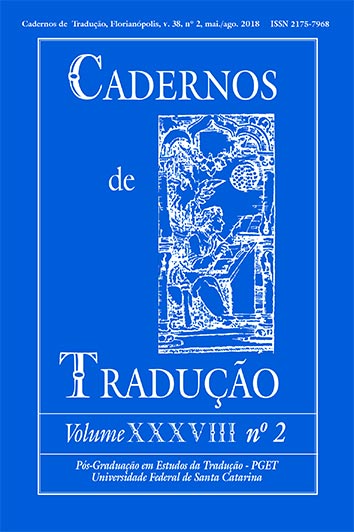Para traduzir o Cânone P?li: a <em>Reine Sprache</em> do outro lado da fita de Möbius
DOI:
https://doi.org/10.5007/2175-7968.2018v38n2p61Resumo
O presente estudo se propõe a analisar algumas potencialidades de tradução do cânone p?li, língua em que estão os escritos do budismo Therav?da. Para tanto, utilizamos o conceito de língua pura (reine Sprache) tal qual formulado por Benjamin. Depois disso, procedemos a uma leitura do conceito à luz da doutrina budista. Assim, defendemos uma Revelação sem Criador, o que nos conduz à ideia de língua pura como parâmetro cármico. Na nossa discussão, apontamos para o traduzir como prática. Em nossa conclusão, traduzimos alguns versos do Dhammapada e os discutimos, e respondemos a algumas possíveis objeções.
Referências
ADORNO, Theodor W. Der Essay Als Form. In: ROHNER, Ludwig. Deutsche Essays – Band 1: Essays avant la lettre. Berlin: DTV, 1972.
BAKER, Mona (Ed.). Routledge Encyclopedia of Translation Studies. London; New York: Routledge, 2000.
BENJAMIN, Walter. Die Aufgabe des Übersetzers. In: ______. Gesammelte Schriften. Bd. IV/1. Frankfurt: Main, 1972.
______. Origem do Drama Trágico Alemão. Tradução de João Barrento. Lisboa: Assírio & Alvim, 2004.
BUDA. Ensinamentos do Buda: uma antologia do cânone páli. Organização e tradução de Nissim Cohen. São Paulo: Devir Livraria, 2008.
_______. Darmapada: a doutrina budista em versos. Tradução de Fernando Cacciatore de Garcia. Porto Alegre: L&PM Editores, 2009
______. Yamakavagga: Pairs (Dhp I). Tradução de Thanissaro Bhikkhu. Access to Insight (Legacy Edition), 30 nov. 2013a. Disponível em: <http://www.accesstoinsight.org/tipitaka/kn/ dhp/dhp.01.than.html>.
______. Yamakavagga: Pairs (Dhp I). Tradução de Acharya Buddharakkhita. Access to Insight (Legacy Edition), 30 nov. 2013b. Disponível em: <http://www.accesstoinsight.org/tipitaka/kn/ dhp/dhp.01.budd.html>.
CAMPOS, Haroldo de. Qohélet = O-que-sabe. São Paulo: Perspectiva, 1991.
COHEN, Nissim. Introdução. In: BUDA. Ensinamentos do Buda: uma antologia do cânone páli. Organização e tradução de Nissim Cohen. São Paulo: Devir Livraria, 2008.
DERRIDA, Jacques. O que é uma tradução “relevante”? Tradução de Olivia Niemeyer Santos. Alfa, São Paulo, v. 44, n. esp., 2000.
DURKHEIM, Émile. Les Formes Élémentaires de la Vie Religieuse: le système totémique en Australie. Paris: Presses Universitaires de France, 1968.
FERREIRA, Aurélio Buarque de Hollanda. Pequeno Dicionário Brasileiro da Língua Portuguesa. Rio de Janeiro: Civilização Brasileira, 1963.
GAIR, James W.; KARUNATILLAKE, W. S. A New Course in Reading Pāli: Entering the Word of the Buddha. Delhi: Motilal Banarsidass Publishers, 2013.
HANH, Thich Nhat. A Arte do Poder. Tradução de Claudia Gerpe Duarte. Rio de Janeiro: Rocco, 2008.
HUMPHRIES, Jeff. The Karmic Text: A Buddhist Reading of Jacques Derrida and Paul de Man Reading Walter Benjamin’s “The Task of the Translator”. University of Toronto Quarterly, v. 66, n. 3, 1997.
KOJÉVE, Alexandre. Introdução à Leitura de Hegel. Tradução de Estela dos Santos Abreu. Rio de Janeiro: UERJ; Contraponto, 2002.
MORGAN, Diane. Essential Buddhism: a Comprehensive Guide to Belief and Practice. Santa Barbara: Greenwood Publishing Group, 2010
ŽIŽEK, Slavoj. First as Tragedy, Then as Farce. London; New York: Verso, 2009.
Downloads
Publicado
Como Citar
Edição
Seção
Licença
Autores têm autorização para assumir contratos adicionais separadamente, para distribuição não exclusiva da versão do trabalho publicada nesta revista (ex.: publicar em repositório institucional ou como capítulo de livro, com reconhecimento de autoria e publicação inicial nesta revista).





















































